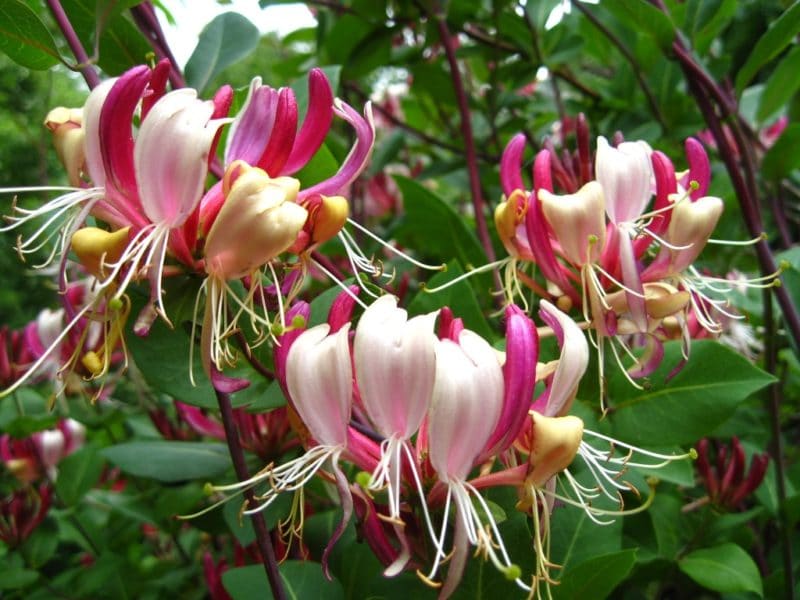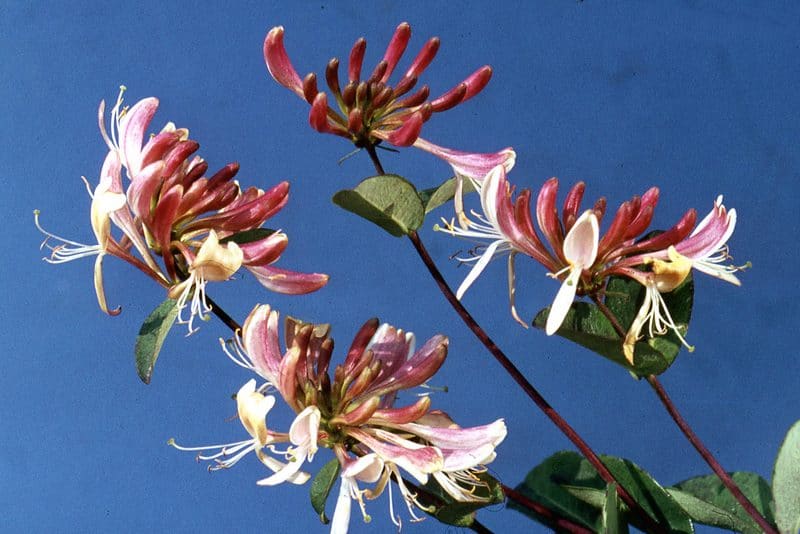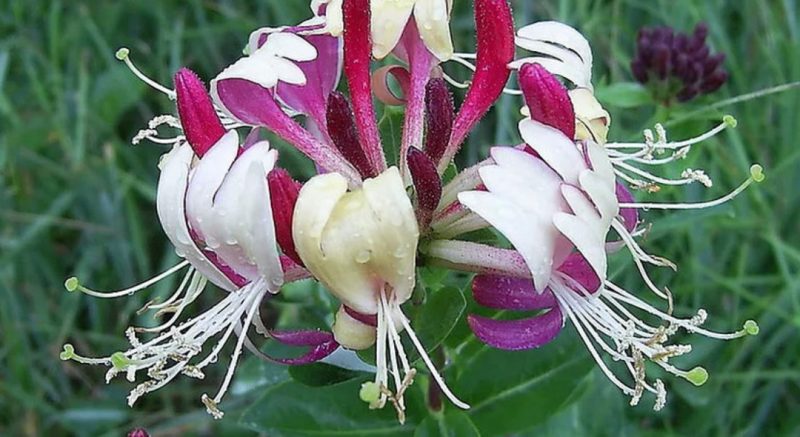Beautiful decorative variety of honeysuckle “Serotina”
Honeysuckle Serotina is a decorative variety of honeysuckle that is loved by landscape designers and amateur gardeners who want to decorate their plots. This unpretentious plant with beautiful and long-lasting flowering is resistant to diseases and pests characteristic of the crop.
Honeysuckle Serotina - description of an ornamental variety

Serotina - late variety decorative honeysuckle, belonging to the species climbing honeysuckle (Lonicera periclymenum). This is a vine-like plant that blooms for several months. It is mainly used for decorative landscaping.
Honeysuckle Serotina (Primorskaya) does not need pollination for several reasons. Firstly, its berries are unsuitable for consumption, which means the yield does not matter. Secondly, bisexual flowers are formed on the bushes, i.e. the plants are able to set fruit without pollinating varieties.
Origin and development
In English, the variety is also called Late Dutch Honeysuckle, which translates as “late Dutch honeysuckle.” Judging by European sources, the culture comes from France.
Reference. This variety is often called “honeysop,” which is incorrect. These are different species of the same genus. Honeysuckle (Loniceracaprifolium) is a separate species, Serotina is a variety of the species Curly Honeysuckle.
Another famous variety of this species is the evergreen honeysuckle Drema. Its leaves remain green even in winter. The plant can withstand temperatures down to -34°C.
Honeysuckle Serotina and landscape design
Serotina honeysuckle bushes are suitable for creating hedges. To do this, they are planted along fences or mesh fences. The shoots rise beautifully and weave along the fence.
Another popular solution among gardeners and landscape designers is to plant a plant near a gazebo. In this case, the vines are allowed to run along the outer wall of the building.
Flowering time
Honeysuckle Serotina begins to bloom at the age of 3-4 years. Flowers appear on the vines in June and remain until September. This period can be extended by promptly picking off fading inflorescences and preventing the formation of berries.
Resistance to diseases and pests
The variety is resistant to diseases and pests, but high humidity leads to the development of fungal diseases, in particular powdery mildew.
Resistance to cold and drought
The bushes tolerate drops in air temperature to -28…-30°C. When freezing, the shoots quickly recover, and the plants do not lose their decorative appearance due to the formation of flowers on new stems.
Honeysuckle tolerates short-term lack of moisture, but the soil should not be allowed to dry out completely. Waterlogged soil and excessive watering provoke the development of powdery mildew and root rot.
Honeysuckle Serotina - characteristics, description of appearance

This is a perennial climbing liana-like shrub 4-5 m high, characterized by rapid growth: the stems grow 1-2 m per year. Young shoots are bare or slightly pubescent.
The leaves are large (length - up to 6 cm), ovoid in shape, located oppositely. Their surface is matte, dark green above, bluish-gray below, turning yellow by autumn.
Reference. The fruits of Serotina honeysuckle have only decorative value and are not suitable for food.
The flowers are two-lipped, bisexual, creamy white inside and purple outside. They have a bright aroma, similar to a blooming linden tree. The berries are bright red, round, can be slightly elongated, reach 1-2 cm in diameter, and appear on the bushes from August to October.
Suitable regions and climate requirements
Despite its high winter hardiness, the variety is heat-loving, so the most suitable regions for its cultivation are the Krasnodar Territory, Rostov Region, Crimea, southern Ukraine, central Russia, St. Petersburg, and the Moscow region.
In areas where winter temperatures drop to -15°C or lower, plants are minimally covered with spruce branches. In the northern regions, stronger shelter is used, for example, spunbond or film.
Advantages and disadvantages
The main advantages of Serotina honeysuckle include:
- fast growth;
- decorative appearance;
- long flowering;
- pleasant and bright aroma of flowers;
- unpretentiousness;
- resistance to common diseases and pests.
Disadvantages include a tendency to be affected by powdery mildew, the need for winter shelter in most regions, and the inedibility of the fruit.
Difference from other varieties and hybrids
Comparison of Honeysuckle Serotina with other decorative varieties presented in the table.
| Variety | Bush height, m | Leaf color | Flower color | Flowering period |
| Serotina | 4-5 | Dark green above and bluish-gray below, becoming yellow | Creamy white with a purple tint | June – September |
| Belgica Select | 4–6 | Green-blue | Yellow-red | May |
| Chick and Chock | 0,8 | Green | Purple pink | June July |
| Harlequin | 3,5 | Green, edged with white or creamy yellow | Pink-yellow | June – September |
| Bush | 6 | Green-gray | Yellow-red | April – August |
Honeysuckle Serotina: agricultural technology
The Serotina variety has standard agrotechnical care requirements. The main thing is to meet deadlines landings, water in a timely manner, feed and trim the plants.
Choosing a place in the garden and preparing holes
To grow Serotina, choose a place protected from drafts and gusty winds, well lit and warmed by the sun. Lack of light negatively affects the flowering of honeysuckle - the flowers form too small or are absent altogether.
The permissible groundwater level is no higher than 1.5 m.
Preparing for landing
When choosing a seedling, preference is given to 1-2 year old specimens with a closed or open root system, shiny green, evenly colored leaves, strong and straight shoots. There should be no damage to the roots, no signs of rotting or disease. All dry areas are removed.
Before planting, the roots of the seedlings are soaked for a day in a solution of a growth stimulant (“Kornevina” or “Epina”). This contributes to the rapid adaptation of plants to a new location.
Soil requirements
Serotina does not make any special demands on the soil, but it is better to avoid swampy soil and places where the soil dries out quickly. The soil must be fertile, light, loose, have good aeration, moisture permeability and a neutral or weak acidity level.
Dates, scheme and rules of planting
Plants are planted on the site in late August - early September, and if the seedlings have a closed root system - during the entire warm period.
Landing rules:
- 2 days before planting, dig planting holes in the selected area with a depth of 25–30 cm and a diameter of approximately 40 cm.
- At the bottom of each hole, pour a 10 cm thick layer of drainage made of expanded clay, broken brick or pebbles.
- Add a nutritious soil mixture (3 kg of turf soil, 1 kg of humus, 1 kg of peat, 200 g of ash, 100 g of superphosphate and 50 g of potassium salt) on top of the drainage layer.
- Place the seedling vertically in the center of the hole, cover it with soil, and compact it slightly.
- Water the plants, mulch the tree trunk with a layer of sawdust.
When growing Serotina honeysuckle as a ground cover plant, the distance between the bushes should be 1.5 m, and with a vertical arrangement - 2 m.
Features of cultivation
The bushes are watered 1–6 times a month at the rate of 40–50 liters of water for each bush, focusing on weather conditions and soil conditions. The soil should not be allowed to dry out or become waterlogged.
After each watering, the soil is loosened - this increases its moisture and breathability, and prevents the formation of a dry crust on the surface.
Plants begin to be fed 2 years after planting. Fertilizers are applied according to the following scheme:
- spring, beginning of the growing season - 10 liters of chicken manure or liquid mullein and 40 g of superphosphate;
- flowering period - complex mineral fertilizer;
- autumn - mulching the tree trunk circle with humus (layer thickness - 5 cm).
When growing bushes in soil with high acidity, the soil is limed every 4 years.
If honeysuckle grows as a ground cover plant, the shoots are regularly shortened to the required length. As a result, the plant takes on the appearance of a kind of lawn. When growing bushes on an alpine hill, they make sure that the shoots grow from top to bottom.
Reference. For bushes older than 6 years, sanitary pruning is carried out, removing dried out, broken stems.
Every year, remove all dry, damaged and frozen shoots in winter.Every 2-3 years in the fall, after the leaves have been shed, rejuvenating and thinning pruning is carried out, removing old and small shoots. The procedure allows you to control the density of flowering: with strong pruning, fewer flowers are formed, but they are larger.
Disease and pest control
The variety is resistant to diseases, but due to high humidity it can be affected by powdery mildew. Sick bushes are treated with preparations containing copper.
In rare cases of pest attacks (most often aphids), the plants are sprayed with an infusion of chamomile and soap. For serious damage, insecticides are used.
Difficulties in growing
Honeysuckle Serotina is an unpretentious plant; its cultivation does not cause difficulties even for novice gardeners. The only problem you may encounter is the appearance of a white powdery coating on the leaves and shoots. This is a symptom of powdery mildew that has developed as a result of high humidity or thick bushes.
Reproduction
Honeysuckle Serotina is propagated in several ways:
- Seeds. Planting material is sown in open ground and watered regularly. Flowering occurs no earlier than 5 years after planting.
- Cuttings. The current year's shoots are cut into pieces 10–15 cm long and planted in a nutrient substrate. Containers with cuttings are kept at an air temperature of +20°C until rooting.
- By layering. Strong shoots are placed in a groove dug in the ground, secured with special brackets and sprinkled with soil. After rooting, the seedlings are separated from the mother bush and planted in a permanent place.
Tips and reviews from experienced gardeners

Experienced gardeners recommend:
- use non-metal supports, then the vines can not be removed from them for winter shelter - this minimizes the risk of damage to the shoots;
- do not lay branches on bare ground, first lay spruce branches and then non-woven material;
- Remove protective material in spring in cloudy weather to avoid the risk of sunburn.
Gardeners speak positively about Serotina honeysuckle.
Raisa, Zelenogorsk: “I won’t hide it, I’m a rather lazy gardener. This is partly why I fell in love with this variety of honeysuckle so much: it requires virtually no care. The seedlings have taken root quickly and well, I water them several times a month, and trimming the bushes is not difficult. At the same time, Serotina blooms incredibly beautifully and for a long time - a real decoration of the garden!”
Valeria, Samara region: “I used to grow another decorative honeysuckle, but its flowering was short-lived. On the advice of friends, I planted the Serotina variety and did not regret it. The flowering is very beautiful and, most importantly, long lasting. For me, this is already enough to be satisfied with the plant, but it has many more advantages, for example, disease resistance and unpretentiousness in care».
Conclusion
Serotina is a variety of ornamental honeysuckle, the bushes of which are characterized by rapid growth, long flowering and the ability to be used as vertical and ground cover plants. Curly Serotina does not have any special requirements for planting and care, and is resistant to most diseases and pests. Among the disadvantages, only the tendency to be affected by powdery mildew as a result of swampy soil and the need for winter shelter are noted.